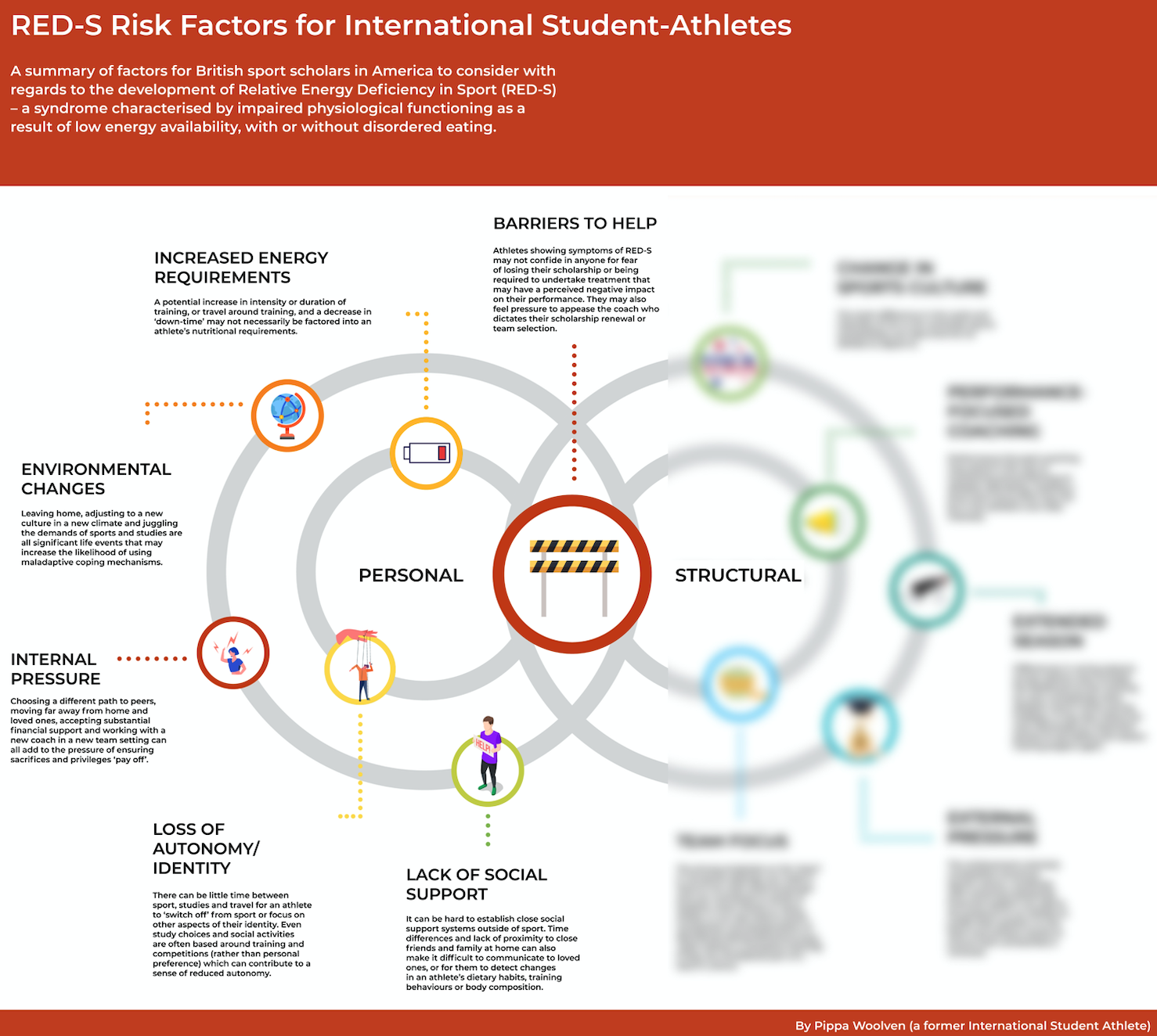American University sport scholarships can be a huge draw for British athletes. World class facilities, free (or heavily subsidised) education, and the promise of an enriching experience offer a once-in a lifetime opportunity for many. Yet with oceans and borders separating them from family, friends and support networks, international student-athletes (ISAs) can face a number of unique challenges. This two-part blog highlights those which have the potential to contribute to Relative Energy Deficiency in Sport (RED-S) – a syndrome of low energy availability with adverse consequences on mental and physical health – with an aim to increase recognition of risk factors among athletes, coaches and parents.
Personal Risk Factors

Environmental changes
Research[1] indicates an association between transitional life events and the onset of disordered eating behaviours. In addition, being surrounded by new foods, new norms and new people at a time when an athlete may be starting to think more about their diet or bodyweight may increase the likelihood of intentional or inadvertent calorie restriction. ISAs may lack the skills or resources to plan, shop and feed themselves sufficiently for their training; they may not always have access to reliable or accurate nutrition advice; and they may feel overwhelmed by the array of commercially promoted products often marketed above wholesome, nutritious foods.
Internal pressure
ISAs are typically hard-working, committed individuals who are driven to achieve their potential. Moving far away from home and loved ones, choosing a different path to peers, accepting substantial financial support and working with a new coach and team can all add to the pressure of ensuring their sacrifices and privileges ‘pay off’. This in turn may increase the likelihood of taking drastic exercise or nutritional measures (like over-training or calorie restriction) in order to improve performance.
Loss of autonomy or identity
ISAs are often encouraged to select classes that fit around their sporting schedule (rather than academic interest or future career aspirations), which can strongly influence their selection of subjects. In addition, between classes, training, conditioning, physical therapy, team meetings and travelling to and from training and competitions, there can be limited opportunities to ‘switch off’ from sport, self-govern other activities, or focus on different aspects of their identity.
Increased energy requirements
Alongside a potential increase in the intensity or duration of training, ISAs may not be used to travelling to training based on the periphery of a large university campus. In the case of some athletics disciplines (e.g. distance running), activities can be based off-site and require a minibus or car journey which can delay the post-training meal. Athletes may not necessarily consider the need for additional nutritional support in line with these potentially substantial changes.
Lack of social support outside of sport environment
The transition to university is often the first time an ISA has lived apart from their primary support system and it can be hard to build close new forms of support outside the sports setting. Changes in time difference and proximity from close friends and family back at home can alter communication channels and make it harder to reach out for support, especially when discussing personal topics over phone or a video-calls. Those overseas are also less likely to be able to detect changes in an ISAs dietary habits, training behaviours or body composition, which can increase the likelihood of overlooking early RED-S warning signs.
Big barriers to seeking help
Due to the internal and external pressures of ISA life, it may be harder for an individual to accept the signs of RED-S. An athlete showing symptoms may not be willing to confide in anyone for fear of jeopardising their scholarship or being required to undertake treatment that may have a perceived negative performance impact. In addition, they may feel under pressure to appease the coach who dictates their scholarship renewal or team selection.
In part two, we will hear about some of the structural risk factors, as well as some suggestions to reduce the risk of ISAs being affected by RED-S in the future.
Author: Pippa Woolven
[1] Berge, J. M., Loth, K., Hanson, C., Croll-Lampert, J., & Neumark-Sztainer, D. (2012). Family life cycle transitions and the onset of eating disorders: a retrospective grounded theory approach. Journal of clinical nursing, 21(9-10), 1355–1363. https://doi.org/10.1111/j.1365-2702.2011.03762.x